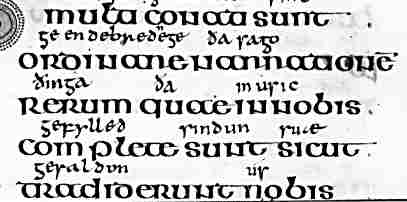Script Type : minuscule, with occasional majuscule letter forms
Alternative Name : insular majuscule
Date : post-Roman era to the 8th century
Location : England and Ireland
Function : Formal book hand, especially used for significant liturgical books such as gospels.


























Distinctive letters : The letters r and n each have two forms, one of which is basically a majuscule shape. d also has two forms, one with an upright and the other with a backsloping ascender. The letter s mainly appears in the short and curly form, but the tall s is present.
a has curled extensions top and bottom making it nearly into a figure of eight on its side. The minuscule forms of r and n are easily confused, although the former has an extra kink on the bottom. f is large and projects below the baseline. g has the open lightning bolt form. u and v are identical. Letters with ascenders such as l and b have strongly wedged tops. The rare letters are not represented in this example.
Although the script is rounded and widely spaced, certain letter combinations run together. For example ti rather resembles an a without the curly extensions, while these extensions on a tend to connect it to the next letter.
Pass the cursor slowly along the Latin text to clarify these features. For a more detailed examination, proceed to the paleography exercises.
Paleography
exercises using Flash![]()
Requires Flash 5 or later plugin
If you are looking at this page without frames, there is more information about medieval writing to be found by going to the home page (framed) or the site map (no frames).